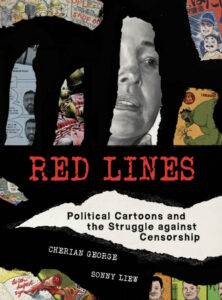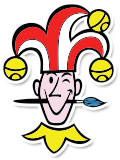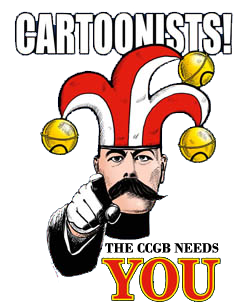By Cherian George & Sonny Liew
Publisher: MIT Press
ISBN: 9780262543019
Political cartooning has taken some considerable knocks over recent decades, with the decline in newspaper and magazine budgets being one of the major reasons. But it’s not just the twilight years of the press barons that have seen the steady erosion of this form of expression. Cherian George, Professor of Media Studies at Hong Kong Baptist University, and Sonny Liew, of the brilliant The Art Of Charlie Chan Hock Chye, have put together this remarkably rich and detailed look at the current state of this most powerful form of cartooning.
Done right, political cartoons can have immense influence. They are inexpensive to produce, swift to react, and easy to understand. As mentioned many times throughout the book, they’re most effective when the cartoonist is punching up, criticising those in power, holding them to account, challenging their actions, and highlighting wrongs. A single talented cartoonist can make a significant difference. But that’s also a problem. A cartoonist is just one person, and when the powerful object to the humour and the scrutiny then censorship comes into play. Increasingly, censorship is silencing more and more cartoonists, and the important voice of political cartooning is slowly being throttled.
Red Lines looks at cartoonists who have faced censorship from across the globe. Some nations are democratic, some are the vehicles of tyrants, but regardless of the country censorship can be found. The censorship takes many forms, from intimidation to being fired, from imprisonment to assassination. It’s financial and commercial pressures put upon struggling newspapers and it’s the growing force of the mob, triggered to react with hostility online or in person to defend their favoured leader, viewpoint or religion. Red Lines breaks down all these forms of censorship by chapter, interviewing the cartoonists at the centre of a personal struggle to be heard, and charting the results. Very few have a positive outcome.
It’s through the experiences of the cartoonists that the book succeeds in sharing the importance of political cartooning. In any society, it’s a simple way of balancing the scales and, without it, everyone is poorer for it.
Sonny Liew’s contribution is to lay the entire book out with a comic aesthetic, combining photography, illustration and typography to great effect. The interviews with cartoonists often utilise speech balloons and a succession of photographic cut-outs set into frames. Alongside the censored cartoons this is extremely effective for context, and for putting a face to the cartoonists. These aren’t anti-government organisations or political wings of a militia, but individuals, holding others to account with pen and paper.
The strongest part of the book comes towards the end with the Charlie Hebdo attack. Having spent the entire book focusing on cartoonists punching up, this final part charts the sorry history and intolerance that culminated in those shocking deaths. It is a tale of censorship and freedom of expression, and although at one point it was punching up against Islamic terrorism, it swiftly became a case of punching down, doing nothing more than mocking a religion. Here the creators of the book tread very carefully along that red line. There is context and relevance in showing the string of cartoons that provoked the outcome, but there’s also the risk of repeating the problem. George and Liew handle it all with sensitivity and balance. For me, this part of the book is worth the cover price alone.
It isn’t all doom and gloom for the political cartoonist, nor for society that benefits from their drawings, ideas and wit. But like so much with the emerging digital environment, not to mention the commercial pressures inherent in print, there’s not a clear path forward – certainly not one that allows the cartoonist to make a living from it. Part of the answer, at least, is to better educate the populace as to the importance of cartoons, and what their existence underscores. On that score, you can do your bit by reading Red Lines.
Red Lines is published on 31st August 2021.
And if you liked that: Get a copy of The Art Of Charlie Chan Hock Chye by Sonny Liew


No comments yet.